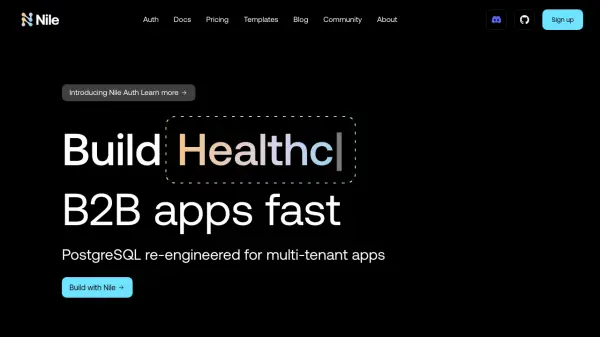What is Nile?
Nile provides a serverless PostgreSQL platform engineered to accelerate the development of multi-tenant B2B applications. It addresses common challenges associated with multi-tenancy, such as data isolation, scalability, and operational complexity, by offering virtual tenant databases within a single PostgreSQL instance. This approach combines the isolation benefits of separate databases with the cost-efficiency and manageability of a shared database model.
The platform incorporates features specifically for modern applications, including support for vector embeddings using the open-source pgvector extension. This enables developers to build multi-tenant Retrieval-Augmented Generation (RAG) applications, storing both relational tenant data and vector embeddings securely and cost-effectively within the same database. Nile features autoscaling capabilities, allowing applications to handle fluctuating workloads, including bursty AI tasks, and offers options for global tenant placement on serverless or provisioned compute for latency optimization and compliance.
Features
- Tenant Virtualization: Provides isolated virtual tenant databases within a single PostgreSQL instance.
- Multi-Tenant Vector Embeddings: Supports storing and querying vector embeddings using pgvector for AI applications like RAG, with tenant isolation.
- Serverless Compute: Offers pay-per-query serverless compute that autoscales with workload demands.
- Global Tenant Placement: Allows placing tenant data and embeddings in different regions on serverless or provisioned compute.
- Autoscaling: Scales compute resources up or down instantly based on tenant workload, including scaling to zero.
- Tenant-Level Management: Includes features for tenant-specific branching, backups, automated schema migrations, and usage insights.
- Cost Optimization: Designed with shared compute and object storage to reduce costs compared to traditional approaches.
Use Cases
- Building multi-tenant SaaS platforms efficiently.
- Developing RAG applications with secure, customer-specific vector data.
- Scaling B2B applications with fluctuating workloads cost-effectively.
- Managing databases for applications requiring strict data isolation between customers.
- Optimizing database performance and cost for AI-driven features in SaaS products.
- Simplifying database operations for multi-tenant architectures.
FAQs
-
How does Nile billing work?
Nile bills based on query tokens consumed on serverless compute and storage used. Billing occurs monthly at the workspace level. Provisioned compute billing is planned for the future. -
What are query tokens?
Query tokens are abstract units representing CPU and memory used by queries on Nile's serverless compute, allowing for usage-based pricing. -
What happens if I exceed the limits of my plan tier?
Nile will contact you as you approach usage limits. You can typically purchase additional capacity without upgrading your tier, even on the free plan. -
Does the database pause on the free tier?
No, databases on the free tier do not pause and have no cold start time due to the multi-tenant serverless architecture. -
Why is Nile's serverless compute cost-effective?
Nile's serverless compute is truly multi-tenant, allowing billing for the exact CPU and memory used per query, which can lead to significant cost savings (estimated 10x) compared to provisioned compute.
Related Queries
Helpful for people in the following professions
Nile Uptime Monitor
Average Uptime
100%
Average Response Time
140.53 ms
Featured Tools
Join Our Newsletter
Stay updated with the latest AI tools, news, and offers by subscribing to our weekly newsletter.











